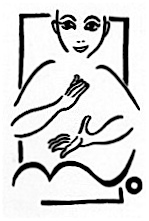 |
Vaitari: A musical picture book from Kerala With transcriptions of basic exercises in English and Malayalam Amsterdam, Ekagrata Publications 2006 ISBN-13: 978-90-75785-04-3 (ISBN-10: 90-75785-04-6) Homepage with video examples and news: wwww.sam.mimemo.net Inquiries and orders: mimemo@icloud.com Introduction Dedication The beauty of vaitari Commitment While musical training is available to virtually all interested children belonging to the middle class of most countries, including India, a great majority of children all over the world have little or no opportunities to develop and share their musical talents. For these reasons and motivated by the joyful response to the learning opportunities offered in the present publication on the side of many able children, those with special needs as well as their educators or guardians, we are committed to facilitating special training programmes for teachers. Donations and proceeds from the sale of this book in excess of funds needed for new editions will serve to make such programmes possible in and outside India on a not-for-profit basis. About the hands-on concept underlying the Vaitari book Vaitari is a broad concept that includes spontaneous vocal expressions of moods, for instance those uttered by family members and friends during a marriage (fantasy icons on page 8) or by the cheering crowds during a boat race (front cover page). Harvest songs (back cover page) also fall into this category. The beauty is that children's poetry and nursery rhymes in all cultures contain elements also found in Kerala's vaitari, just as the technical syllables (jati) used for notating, practicing and remembering dance movements (adavus) or drum strokes (Tamil "solkattu"). The word vaitari thus denotes a characteristic approach to learning and remembering involving body along with all the senses, emotional appeal and imagination. Hence the artist's visual references to all these arts, customs, mythology and folklore. The famous peace mantram (page 15) completes the picture. The use of the hand gestures in learning singing seen on page 16 brings together the customary dance gestures (mudras or hastas) seen in Kerala's graceful Mohiniyattam dance (centre spread) and the century-old European tradition of teaching singing. The inclusion of this ingenious method, adapted in accordance with the gestures presently taught in the teachers' training programme of the Bern University of the Arts, is based on the experience that singing is often accompanied by initial bad postures on the part of learners that inhibit proper breathing and thereby free vocal expression. Using these gestures on the basis of the book's illustrations helps learners to free themselves from their physical and mental inhibitions and approach the singing of any series of notes from which an Indian raga can be formed either with the help of a recording or in the presence of an experienced Indian teacher. Being designed for modern children and youngsters as well as their educators, the authors have brought in their respective experiences from different fields and arts to make the book an intercultural as well as an interdisciplinary experience. In other words, different people are bound to make different use of it, whether or not they follow the arrangement of the book's pages. There is, of course, a plan underlying the arrangement which should make a difference to educators seeking to make good use of that one "window in time" during which they can freely interact with those entrusted to them, including those with special needs, with the help of ideas from India. Finally, a word about the didactic concept that teachers may profit from with the help of this publication: It is now news for an experienced educator to read that it is their innate curiosity that makes children concentrate and cooperate in a classroom. The artwork created for this book is designed to kindle their sense of wonder in order to get involved, become creative and, where time and environment permit, resort to peer teaching. In this sense it is indebted to Dr. Maria Montessori's method for teaching young children to become self-confident personalities valuing achievement as much as empathy. Her learning psychology and teaching ethics, which has gained an enormous following the world over and evolved over a period of over a century and even reached the true elite of the Indian subcontinent. Three phases of involvement Here it is worth recalling that the findings of modern brain science confirm that memory is based on a vast array of "synaptic junctions", expanded and maintained with the help of countless associations, movements, emotional responses, repetitions and permutations rather than in a straightforward manner in order to be lasting. Although the plan of the inside pages of the present book are broadly arranged on the lines of "Concentration - Cooperation - Memory" in that sequence, any particular page including the front and back cover pages could serve as starting point for a personalized route taken for one's personal journey through Kerala's vast and varied cultural landscape! Credits This production and the research project preceding it have been made possible by the Bern University of the Arts (Switzerland) in conjunction with Natanakairali Research and Performing Centre for Traditional Arts (India). Contributors: P. Nandakumar (idakka), Kalanilayam Prakash (maddalam), Aparna Nangiar (Nangiar Koothu), Bindu Sundaresan and Bindu Sajeevnath (dance vocal); Thrikkamburam Krishnan Kutty Marar (Kerala tala vaitari); Emanuel Wüthrich (adaptation of Curwen/Kodály gestures for Indian music). Special thanks to all the children at Natanakaisiki (Mohiniyattam Gurukulam), Nirmala Paniker's disciples and Sankaran Nair (hospitality). For inquiries regarding teachers' training in the methods outlined in this publication contact: G. Venu, Director
Getting into the flow (*) Daniel Goleman. Emotional Intelligence: Why it can matter more than IQ. Bantam Books. New York, 1996. | |
sam.mimemo.net
|